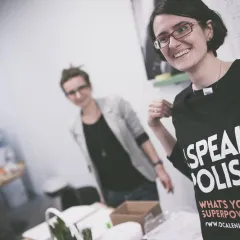The area of today’s Azerbaijan is inhabited by one of the largest Jewish diasporas in the Caucasus: Mountain Jews, Ashkenazi Jews and Georgian Jews. The oldest of those groups is the community of Mountain Jews, who, according to most historians, appeared here in the 6th century. It is believed that the history of Azerbaijani (Mountain) Jews is the integral part of the common history of the Jewish nation. The quick development of oil industry in Baku (the capital of Azerbaijan) in the first half of the 19th century played a key role in the migration of representatives of various nations, including Jews. Most of those people were intellectuals: engineers, teachers, physicians, lawyers.
Despite the fact that they have been living with close to the Azerbaijani people, the Jews preserved their language, traditions, customs and lifestyle, and are more orthodox than, for instance, their fellow-countrymen in the West.
The Kuban region of Azerbaijan – one of the most picturesque places in that country – is situated in the North-East of the country. Some people confuse the name of that region with the insular state of Cuba, in Middle America, in the Caribbean Sea. The tale of the Azerbaijani region uncovers the history of that nation who has inhabited Kuban area for many years. There is a village called Krasnaja Słoboda (a kind of settlement), related to the long history of Mountain Jews, who contributed greatly to the development of that area. The village of Krasnaja Słoboda is the only place populated densely by Jews (approx. 4 000 people) in the post-Soviet territory. Many scientists see this fact as a phenomenon in modern life. The history of Słoboda began in 1722, when Jews were given the right to settle in that area. In 1758, after the death of Hussein Ali Khan, the Kuban khanate, which, by that time, was a part of Russia, was inherited by Hussein Ali Khan’s Son, Fatali Khan. Kuban became a stronghold of strategic significance and was often referred to as the “Gala,” which means “the fortress.” The Jewish district was situated in the intersection of caravan routes and was quite important. A notable group of Jews appeared there, after the Kuban Khan promised to help the Jewish elders and religious leaders in a number of ways.
The synagogues are the most important element of the Mountain Jews’ social life. The earliest mention of the synagogues appeared in the beginning of the 18th century, but only those which were built much later have managed to last until now (See: 1).
As to the architectural planning, the synagogues of Mountain Jews are to a large extent similar to the architecture of mosques in that region, inhabited by a given community. No wonder Mountain Jews call the synagogue the “nimaz,” which is actually a Muslim word. What is interesting about the synagogues in Krasnaja Słoboda, is the fact that we know the name of the architect – it was Hillel Chaim, born in that village. In Słoboda, one can also find houses which were designed by him. Each synagogue has a facade with big brick Hebrew letters signifying the first name and the family name of the builder. This original autograph is one of few ornaments of rather modest facades of the synagogues. The synagogues of Mountain Jews have characteristic ritual vessels. Mountain Jews, Ashkenazi Jews and Georgian Jews, contrary to other Persian-speaking communities, cover the Torah with a textile coat and read it at a table, which stands on the so-called Tewa (i) .
In the past, Mountain Jews were occupied mainly with farming: they did gardening, grew grapevines, madder (for producing natural dyes), tobacco, and they also caught fish in the Caspian Sea or were employed as seasonal workers in neighbouring villages. Among their traditional trades was tanning. Mountain Jews also took to trade; among them there were rich merchants selling rugs.
A Mountain Jew has always been a typical Caucasian highlander placed in the context of inter-tribal and interpersonal relations such as fraternity, vendetta, etc., which were controlled by the “adat” (tradition and code of conduct), which is a customary law. The ethnographers very often highlighted the good relations between Mountain Jews and Muslim highlanders.
In 1888, Ilya Anisimov (ii) published a very interesting and probably unique ethnographic book on research related to the life of Mountain Jews. In his book, I. Anisimov conducted a meticulous analysis of differences between religious beliefs of Ashkenazi Jews and Mountain Jews. Moreover, by indicating the similarities between the languages of Mountain Jews and Caucasian Persians (Tats), he concluded that Mountain Jews are the descendants of the Iranian tribe of Tats, who converted to Judaism in Iran and, after that, moved to the East of Caucasus. The language of contemporary Mountain Jews (in literature referred to as Jewish-Tati, Mountain-Jewish or Tati), as regards its origins, is Middle Persian, i.e. a Persian language since the times of the Sassanid dynasty.
Recently, in the Azerbaijan Manuscripts Institute, an exciting discovery was made – the manuscript of Nizami’s (iii) poem written in the Hebrew alphabet was found. There is another similar manuscript containing Jewish ballads – various stories related to the Bible. Those manuscripts are unique, because, despite the fact that they have been written in the Hebrew alphabet, the language they have been written in is Persian. This is because the manuscript has been written by Mountain Jews (Tats), whose literary language until the 19th century was Persian. The discrepancies between the language of the poem and the alphabet misled some Azerbaijani scholars and readers from abroad. One time, however, the Baku Manuscripts Institute was visited by a citizen of Israel, who was unable to read the text, as “the text of the manuscript has been written in an incomprehensible language, using an unknown alphabet.” This can be to some extent understood, as the Persian text in the Hebrew alphabet may confuse the amateurs (See: 3).
The Jewish community in Azerbaijan has hardly ever encountered anti-Semitism. Many members of the community participated actively in political, economic and cultural life of the republic. Even now, in Baku, one may encounter memorial tablets on the buildings where the eminent members of the Jewish community lived, among them: the scientist and Nobel Prize winner, Lev Landau, the prominent doctor, Solomon Guzman, the Azerbaijani national hero, Albert Agarunov (iv) and many more. One should also mention talented musicians born in Baku: the eminent cellist and conductor, Mstislav Rostropovich or the composer, Leonid Weinstein.
Hijran Aliyeva
Bibliography:
1) Gorski J., Górski żydzi. Historia, etnografia, kultura, http://www.aksakal.info/news-mountain-jews/11846-istoriya-i-arhitektura-gorsko-evreyskih-sinagog.html
2) Ibrachimow-Sznejder M. in: „Aziz”, Baku 11.1996.
3) Alekperow F., Zabytyje pismena drewniego Azerbajdzana, in: „Zerkalo”, Baku 22.04.2004.
4) http://gorskie.ru/commune/ob-az.htm
(i) Tewa – the ark saved the whole mankind first and after that, it saved Moses, a man chosen by God to lead Israeli people out of Egypt, a place of torment, enslavement and alienation. See: Tewa – the ark of the word, http://www.dekalog.pl/jbpwroclaw/guppy/articles.php?lng=pl&pg=124
(ii) Anisimov (1862-1928) was the first Mountain Jew to receive higher education in Russian universities.
(iii) Nizami Ganjavi, a poet from the city of Ganja (in the western part of today’s Azerbaijan), wrote in Persian and in Turkish.
(iv) A. Agarunov died on the 8th of May 1992, during the fight for Shusha (a town in the self-proclaimed republic or Mountain Karabakh).
Translated by: Mateusz Pazdur








